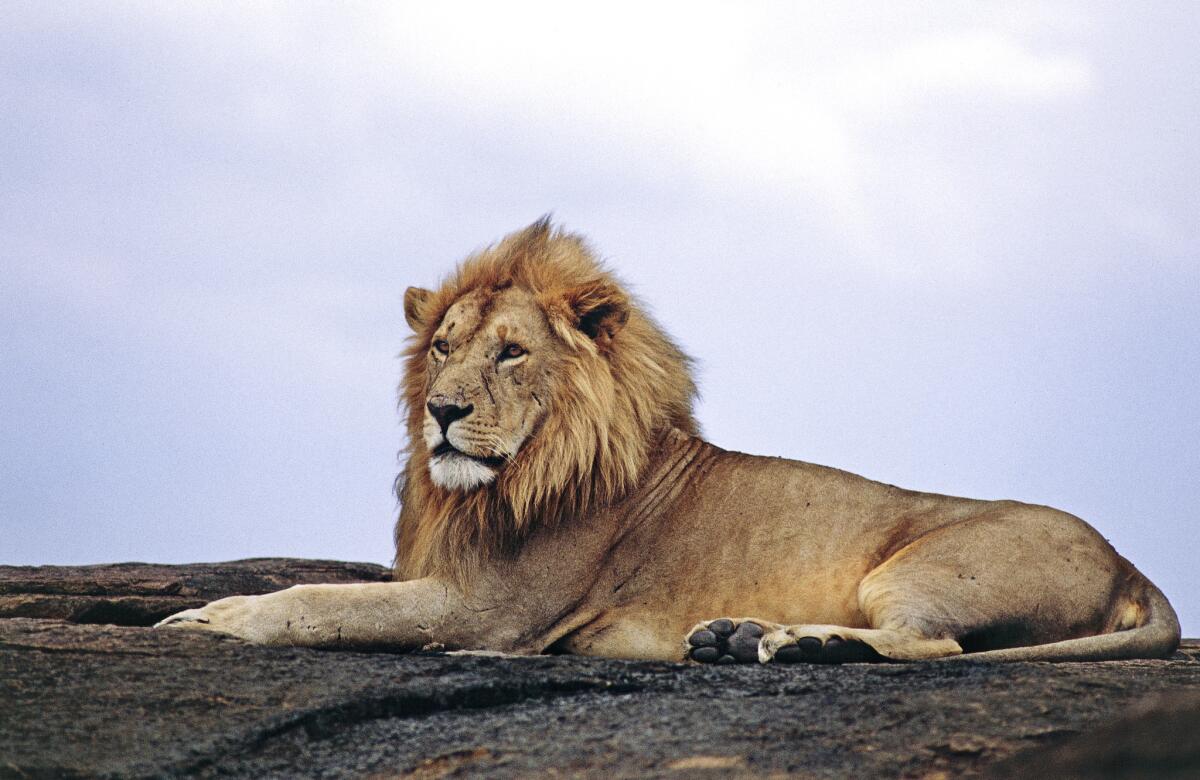Is this Cecil’s legacy? What you can do to protect the lions, elephants and rhinos in Africa

A lion relaxes at the Maasai Mara National Reserve in Kenya.
- Share via
NAIROBI, Kenya — The plight of Africa’s animals has been the focus of media attention since Zimbabwe’s beloved Cecil the lion was killed last month by an American hunter. But lions are often killed in Africa, as are many other wild animals.
The week after Cecil was lured out of Hwange National Park in Zimbabwe and shot, five elephants were gunned down in Tsavo West National Park in Kenya and their faces cut off for the tusks. They didn’t make headlines, maybe because they didn’t have human names.
Lions, elephants and rhinos are severely threatened by poaching, local conflict and foreign trophy hunters. This means that three of the “Big Five” animals most tourists want to see in Africa are now on the road to extinction.
The illegal wildlife trade (live animals, skins and parts) is, according to Public Radio International, a $20-billion annual industry. Is this a reason to get to Africa quickly? Sadly, yes. It’s also a reason to make sure your tourism dollars support deserving causes if you do.
I felt a sense of urgency, so I looked for a safari company that had contacts with East African camps involved in conservation. I booked through Delaware-based Kensington Tours, a bespoke company that listened to my requests and delivered what I requested: safari lodges that were involved with animal conservation and locations where I didn’t have to sit all day in a Jeep.
Ol Donyo Lodge, a high-end safari camp at the base of the Chyulu Hills in southeastern Kenya, was founded by Richard Bonham and is now part-owned by Great Plains, an organization that uses tourism to sustain wildlife programs.
Ol Donyo is luxurious, ecologically friendly and has some of the most knowledgeable Maasai guides I have encountered.
Most important, some of my safari dollars went to protecting the animals I’d come to see, and once there, I had an opportunity to donate to specific programs. I chose to pay school fees ($400) for a high-achieving Maasai child to become a “Wildlife Scholar,” meaning he or she would become an anti-poaching community activist.
My room had its own plunge pool, an open-air living area with slipcovered sofas, and a rooftop bed ideal for stargazing. Below my hilltop room was a watering hole, filled with water recycled from camp use, which attracted elephants and other species up close.
Guests do not have to dine communally, as in many safari camps, and because it’s on Maasai-owned land rather than in a national park, Ol Donyo offers horseback and walking safaris as well as mountain biking, making it a more active destination than your average safari location.
One of the guides told me that the place itself has strong energy, and I believe it. That, combined with excellent food and service, exhilarating adventures and the privacy of the lodge, made it one of the best stays I’ve had in many trips to Africa.
Kensington had arranged for a car and driver to take me across the border into Tanzania, a country that has lost more than 60% of its elephants to poaching.
At family-oriented Oliver’s Camp in Tarangire National Park in Tanzania, the focus is not on direct elephant conservation, but on providing the locals with education and alternative sources of income. All of its guide staff were local Tanzanians, as were the camp employees. It also trains young people to enter the tourism industry.
The camp was simpler than Ol Donyo and can accommodate as many as 24 guests in spacious tents with attached bathrooms. Dining was communal.
Tarangire has plentiful populations of elephant, wildebeest, giraffe, zebra, buffalo, impala, gazelle, hartebeest, oryx, eland and the strange, long-necked gerenuk. One of my favorite sights was a nocturnal porcupine caught in daylight, bustling noisily along a dirt road like a character from “The Wind in the Willows.”
It was heartening to see elephants thriving in Tarangire, but I did notice one thing: They had smaller tusks than those I saw in Kenya. Perhaps this is a Darwinian response to the human massacre?
What can travelers do?
First and foremost, going to Africa to support tourism is a good start. Stay at camps actively involved in conservation. Never buy anything that looks like ivory even if the seller tells you it’s old. And if you are a hunter, perhaps look deep inside your soul.
::
If you go
THE BEST WAY TO NAIROBI, KENYA
From LAX, KLM, Turkish, Etihad, Ethiopian, British, China Southern, Delta, American and United offer connecting service (change of planes) to Nairobi. Restricted round-trip fares range begin at $956, including taxes and fees.
Kensington Tours, www.kensingtontours.com; (888) 903-2001. Can customize trips for most preferences and budgets.
WHERE TO STAY
Ol Donyo Lodge, Chyulu Hills, Kenya; www.lat.ms/1V5K9eU. From $800 per person, per night. Includes all food, drink and activities.
Oliver’s Camp, Tarangire National Park, Tanzania; www.lat.ms/1ha0jVI. From $550 per person, per night. Includes all food and activities.
Arusha Coffee Lodge, Tanzania; www.lat.ms/1hXzOU9. From $550 per night. Good place to stay when traveling between Kenya and Tanzania.
TO LEARN MORE
David Sheldrick Wildlife Trust, Nairobi, Kenya, www.sheldrickwildlifetrust.org. Open daily from 11 a.m. to noon, when orphaned elephants receive their midday feeding and mud bath. $7 minimum contribution. After-hour appointments available for visitors who have fostered elephants (can be done online) and want to visit their “baby.” The trust also fosters rhinos. Maxwell, a blind white rhino, has spent most of his life at the trust and is a favorite. You can see him up close, which is well worth the price.
iWorry, www.iworry.org. Its campaign, created by the David Sheldrick Wildlife Trust, seeks to protect elephants by raising awareness of the threats facing the species.
African Wildlife Foundation, www.awf.org. Works to ensure the survival of wildlife and wild lands in Africa.
Big Cats Initiative, animals.nationalgeographic.com/animals/big-cats-initiative. Seeks to stop the decline in the numbers of big cats; a project of filmmakers Dereck and Beverly Joubert and National Geographic.
Save the Rhino, www.savetherhino.org/africa_programmes. Supports field programs in Kenya, Tanzania, Zambia, Zimbabwe, Namibia and South Africa.
ALSO:
The hidden consequences of hunting Africa’s lions
Help rescue wolves, toucans and other wildlife -- and see the world
At a wildlife center in Indonesia, macaques are readied for a return home
Like orangutans? You can volunteer at a ‘forest school’ for them in Indonesia
African rhinos face extinction by end of decade because of poaching for horns
More to Read
Sign up for The Wild
We’ll help you find the best places to hike, bike and run, as well as the perfect silent spots for meditation and yoga.
You may occasionally receive promotional content from the Los Angeles Times.






